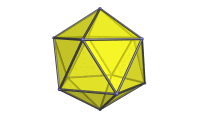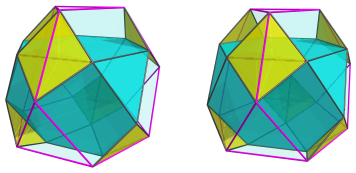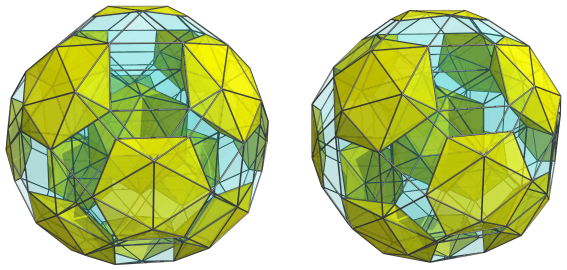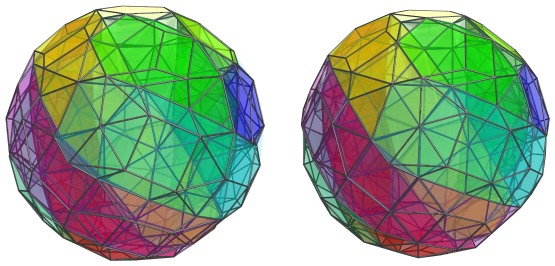4D Euclidean space
News Archive
June 2018
This month, we introduce another scaliform polytope (a polytope that is vertex-transitive, albeit not necessarily uniform):
This is the truncated tetrahedral cupoliprism, or tutcup for short. It is formed from the convex hull of two truncated tetrahedra placed in dual orientation to each other in parallel hyperplanes, and has 6 tetrahedra and 8 triangular cupolae connecting the two truncated tetrahedra. It is listed as K4.55 among Dr. Klitzing's convex segmentochora.
Go to the truncated tetrahedral cupoliprism page to find out more about this cute little scaliform polytope. As usual, we provide the full coordinates.
19 Jun 2018:
8 Jun 2018:
1 Jun 2018:
The Polytope of the Month for June is up!
May 2018
This month's Polytope of the Month is a modification of the familiar snub 24-cell:
This is the runcinated snub 24-cell, an interesting polytope that, even though it is not uniform, is nevertheless vertex-transitive and CRF, thus belonging to the class of scaliform polytopes. As its name implies, it is derived from the snub 24-cell by radially expanding the 24 icosahedral cells outward. The remaining gaps are filled in by 24 truncated tetrahedra, 96 triangular cupolae, and 96 triangular prisms.
Check out the runcinated snub 24-cell page to explore the structure of this interesting polytope. As is customary, we provide full coordinates.
28 May 2018:
24 May 2018:
Added two special Johnson solids:
Full algebraic coordinates, given as defining polynomials and root intervals, are provided for both polyhedra, along with high-precision numerical values.
17 May 2018:
16 May 2018:
15 May 2018:
Added the pentagonal orthobirotunda (J34), yet another Johnson solid.
14 May 2018:
Added the pentagonal orthocupolarotunda (J32), a Johnson solid that has an interesting relationship with the icosahedron, as shown by the following animation:

Added the pentagonal gyrocupolarotunda (J33), another Johnson solid.
1 May 2018:
The Polytope of the Month for May is up!
Added more Johnson solids:
Apr 2018
This month we present a beautiful specimen of a CRF polytope that exemplifies the fascinating structure of the Hopf fibration of the 4D sphere. This structure is actually present in all of the regular polychora, but it is hidden within their higher degree of symmetry. In the swirlprismatodiminished rectified 600-cell, however, this higher symmetry is stripped away, leaving bare the Hopf fibration substructure.
Also known by its Bowers Acronym spidrox, this polychoron, in spite of being non-uniform because of its square pyramid cells, is nonetheless vertex-transitive and has equal edge lengths, and thus belongs to the class of scaliform polytopes. Its 600 square pyramids form 20 rings that wrap and twist around the 12 rings formed by its 120 pentagonal prisms and 120 pentagonal antiprisms, forming a marvelous 4D structure that corresponds with the discrete partitioning of the Hopf fibration according to the structure of the icosidodecahedron.
So head on over to the spidrox page to learn the structure of this beautiful polychoron. As usual, we provide the full coordinates.
19 April 2018:
17 April 2018:
Added the gyroelongated square cupola (J23), a Johnson solid.
16 April 2018:
Added the decagonal antiprism, a 3D uniform polyhedron.
14 April 2018:
Added the octagonal antiprism, a 3D uniform polyhedron.
12 April 2018:
Added the hexagonal antiprism, a 3D uniform polyhedron.
Added the gyroelongated triangular cupola, a Johnson solid.
Updated family portrait for the uniform polyhedra.
11 April 2018:
9 April 2018:
8 April 2018:
Added the pentagonal bipyramid, the 13th Johnson solid.
7 April 2018:
4 April 2018:
Added the metabidiminished rhombicosidodecahedron, the 81st Johnson solid.
1 April 2018:
The Polytope of the Month for April is up!







